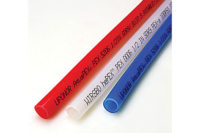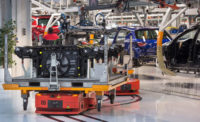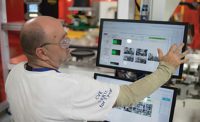Faurecia has been the world’s largest manufacturer of vehicle interiors for the past several years. Automotive OEMs all over the globe install the company’s seats, dashboards, center consoles, door panels, acoustic modules and decorative elements.
About six years ago, Faurecia initiated a global digital transformation program. One aspect involves the digitalization of its lean manufacturing pull system. In this system, parts used in the manufacturing process are only replaced after they have been consumed.
Another facet is using artificial intelligence to visually inspect parts, thereby improving quality and reducing process variability. The final aspect is the deployment of 680 cobots and 920 automated guided vehicles (AGVs) to improve plant operations.
In the fall of 2018, Faurecia began using 26 AGVs at its plant in Vitoria-Gasteiz, Spain, after implementing the Siemens Warehouse Management System. This system—which also includes 200 metal transfer carts, an end-of-line buffer and sequencing—optimizes the delivery of car seats made for Mercedes-Benz.
After being assembled, each seat is lifted by a worker and placed on a transfer cart. Beneath the cart is a mobile K05 Twister AGV, which raises its platform and moves through the plant to bring the seat to a specific workstation. There, a worker mechanically lifts and guides the seat onto an overhead conveyor before sending a signal to the AGV that tells it when to return to its initial loading position and start another cycle.
Kivnon Logistica S.L.U. makes the K05 Twister, which Faurecia selected because it rotates 360 degrees on its own axis. This capability makes the AGV ideal for use in confined spaces.
“This flexible system automates loading and storage seat sequencing,” says César Lafraya Soret, director of the Faurecia Vitoria-Gasteiz plant. “[It also] allows fast layout modifications and the opportunity to quickly and simply increase capacity, [including] the number of AGVs.”
Soret says the KO5’s reliability stems from several in-loop battery charging stations that work 24/7. Faucia also uses the RFID reader within the AGV’s lifting platform to verify the ID number of each seat before it is moved to a worker for placement on the overhead conveyor.
“This system shows where the AGV market is going,” explains Rob Keij, sales director at Kivnon. “Besides the traditional trips designed for an AGV to take material from [point] A to B, [manufacturers] demand intelligent technologies and route programming in AGVs.”
The K05 uses magnetic guidance to navigate around the plant floor. It has a maximum onboard load capacity of 500 kilograms, with a towing capacity of up to 1,000 kilograms on a wheeled cart.
Another key AGV capability is it connects to various fleet management systems, including those based on the VDA 5050 interface. The K05’s coupling system comes with different options (retractable pin, lift table, roller conveyor) for on-board or towed loads.
Maximum speed of the AGV is 1 meter per second. Its power comes from an absorbed glass-mat or lithium battery that is charged by an integrated circuit. The AGV can also be used as a workbench.
For more information, call 34-933-0349-62 or visit www.kivnon.com.




